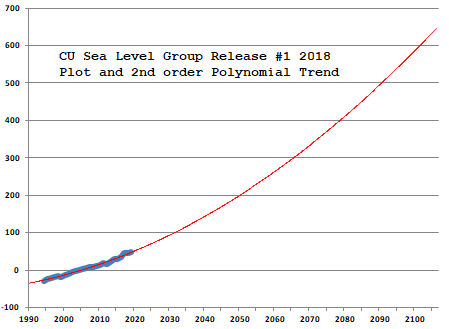steve case
Well-known Member
- Joined
- Apr 10, 2002
- Messages
- 823
My data looks like this:
1992.960 -31.0
1992.985 -33.1
1993.010 -30.9
1993.039 -33.0
1993.064 -35.8
and so on for 900 lines
Time intervals in column "A" are variable and sometimes missing
and column "B" variables wobble up and down mostly up.
I can easily find acceleration using the slope for the first 450 lines
and the second 450 lines with the formula we all learned in 12th
grade physics (v2-v1)/t=a but it doesn't fly if you let on that that's
what was used to come up with nearly the same answer that taking
the 2nd derivative of the quadratic fit finds. I was never a calculus
student so I need a cook-book answer. I've done an internet search
and a Mr. Excel search and I haven't found anything specific or that
I understand that can be plugged into Excel to find "a" by taking the
2nd derivative of the quadratic.
I'm hoping for X values in column "A" and Y values in Column "B"
with formulas in Columns "C" "D" ... etc. copied on down all the lines
that maybe even give me an answer after the first few rows for a value
of "a" for each row from the beginning (-:
I'm not really asking an Excel question it's more like asking for help
with math. So if that's not what Mr. Excel does, my next step is off to
the the local university and a math tutor. I'm prepared to do that.
1992.960 -31.0
1992.985 -33.1
1993.010 -30.9
1993.039 -33.0
1993.064 -35.8
and so on for 900 lines
Time intervals in column "A" are variable and sometimes missing
and column "B" variables wobble up and down mostly up.
I can easily find acceleration using the slope for the first 450 lines
and the second 450 lines with the formula we all learned in 12th
grade physics (v2-v1)/t=a but it doesn't fly if you let on that that's
what was used to come up with nearly the same answer that taking
the 2nd derivative of the quadratic fit finds. I was never a calculus
student so I need a cook-book answer. I've done an internet search
and a Mr. Excel search and I haven't found anything specific or that
I understand that can be plugged into Excel to find "a" by taking the
2nd derivative of the quadratic.
I'm hoping for X values in column "A" and Y values in Column "B"
with formulas in Columns "C" "D" ... etc. copied on down all the lines
that maybe even give me an answer after the first few rows for a value
of "a" for each row from the beginning (-:
I'm not really asking an Excel question it's more like asking for help
with math. So if that's not what Mr. Excel does, my next step is off to
the the local university and a math tutor. I'm prepared to do that.






